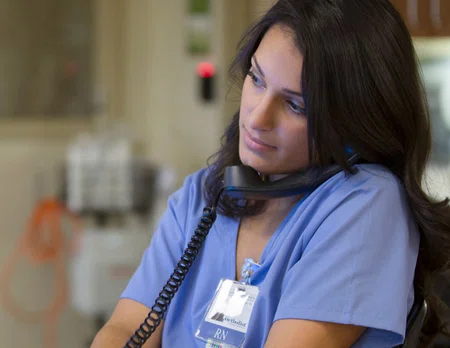© 2024. Houston Methodist, Houston, TX. All rights reserved.


In this
issue

WELCOME
NURSING SCIENCE

Prioritizing Nurse Perspectives in Technology Design

Brand Image of the Nursing Profession

Meet Houston Methodist’s Newest Nurse Scientists!
EDUCATION
PRACTICE

Unlocking Excellence: Practicing at the Top of Your License

Compassionate Care: Supporting and Caring for Nurses
PROFESSIONAL DEVELOPMENT
MAGNET
FROM OUR TEAMS

ABOUT DISCOVERN
NURSING SCIENCE
Prioritizing Nurse Perspectives in Technology Design
By Michelle C. Hehman, PhD, RN, NPD-BC
By Michelle C. Hehman, PhD, RN, NPD-BC

Modern nursing practice demands a high level of technological competence. Nearly every aspect of daily patient care — from the monitoring equipment that aids in patient assessment to the therapeutic and life-sustaining devices prescribed for disease management to the electronic health records used for documentation—requires complex interaction with advanced technology beyond a simple user interface.
Nurses don’t just use technology. They manage and respond to it, which comes with almost end-to-end responsibility. This means nurses must know how to properly set up the technology to ensure accurate patient data is inputted, understand how to gather and interpret the information the technology provides, and then use that information to make decisions about patient care, calculating data trends, evaluating the patient’s changing condition or response to treatment, and determining whether new or further action is needed (Ruppel and Funk, 2018).
Despite being the primary end-users, nurses are rarely invited to participate in early design and implementation planning for most health technologies, leaving these critical processes to people unfamiliar with nurses’ workflows or the complexities of the modern healthcare environment. Consequently, the integration of new technology is often fraught with complications as nurses are forced to address process inefficiencies and product malfunctions in real time, which significantly increases individual nurse workload burden and frustration (Dykes and Chu, 2021). In these situations, nurses create workarounds or abandon the technology to complete patient-related activities on time, sometimes overriding technology features specifically intended to improve the quality and safety of care (Brown et al., 2020; Lakshmi and Arriaga, 2022). These unanticipated challenges pose a serious patient safety risk and contribute to preventable adverse events, much of which could have been avoided by including a nursing perspective during product development.
Given the recent, rapid advancements in artificial intelligence, robotics, and other digital technologies and future predictions of the nurse labor shortage, it is reasonable to assume that even more technology will make its way into nursing workflows. Nurses must, therefore, be actively involved in the research, development, and acquisition processes if we hope to ensure these technologies create a long-term positive impact on nursing practice and improve patient care quality, safety, and efficiency (Zhou et al., 2021). Technology initiatives need cooperative design approaches that center on a nursing perspective, and nurses must learn to value their experience and expertise in product innovation. This will require a shift in thinking for both technology developers and nurses, along with genuine attempts to develop shared language and understanding of the use of technology within complex health systems.
References:
- Brown, J., Pope, N., Bosco, A.M., Mason, J., & Morgan, A. (2020). Issues affecting nurses’ capability to use digital technology at work: An integrative review. Journal of Clinical Nursing, 29(15-16): 2801-2819. https://doi.org/10.1111/jocn.15321.
- Dykes, S. & Chu, C.H. (2021). Now more than ever, nurses need to be involved in technology design: Lessons from the COVID-19 pandemic. Journal of Clinical Nursing, 30(7-8): e25-e28. https://doi.org/10.1111/jocn.15581.
- Lakshmi, U & Arriaga, R.I. (2022). Warm solutions: Centering nurse contributions in medical making. Proceedings of the ACM on Human-Computer Interactions, 6(CSCW2): Article 351. https://doi.org/10.1145/3555771.
- Ruppel, H. & Funk, M. (2018). Nurse-technology interactions and patient safety. Critical Care Nursing Clinics of North America, 30(2): 203-213. https://doi.org/10.1016/j.cnc.2018.02.003.
- Zhou, Y., Li, Z., Li, Y. (2021). Interdisciplinary collaboration between nursing and engineering in health care: A scoping review. International Journal of Nursing Studies, 117: 103900. https://doi.org/10.1016/j.ijnurstu.2021.103900.









